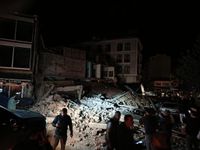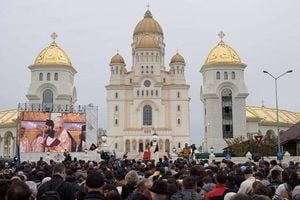Western Turkey was rocked late Monday night by a powerful magnitude 6.1 earthquake, sending shockwaves through the Sındırgı district of Balıkesir province and rattling nerves across some of the country’s largest cities. The tremor, which struck at 10:48 p.m. local time on October 27, 2025, was recorded at a shallow depth of 5.99 kilometers (3.72 miles), according to Türkiye’s Disaster and Emergency Management Authority (AFAD). Its effects were felt well beyond the epicenter, shaking buildings and sending residents fleeing into the streets in Istanbul, Yalova, Bursa, Manisa, and Izmir.
The quake’s impact was immediate and widespread. According to AFAD, three buildings collapsed in Sındırgı: two on Akhisar Street and one in Cumhuriyet Square. The two four-story buildings on Akhisar Street had already been vacated and sealed after sustaining damage in a previous 6.1-magnitude quake on August 10, 2025, and were awaiting demolition. The two-story building in Cumhuriyet Square housed three shops on its ground floor, with storage space above. Fortunately, these structures were unoccupied at the time of the collapse, preventing a potentially tragic outcome.
Interior Minister Ali Yerlikaya addressed the nation’s concerns in a statement on social media, reassuring citizens that, "all teams from AFAD and our relevant institutions immediately began field surveys." He added, "I offer my best wishes to our citizens affected by the earthquake. May God protect our country and our nation from disasters." President Recep Tayyip Erdoğan echoed these sentiments, stating, "I extend my condolences to the citizens affected by the earthquake that occurred in the Sındırgı district of Balıkesir and was also felt in our neighboring provinces. Our AFAD, along with the relevant units, is meticulously continuing inspection and control efforts in the field. We are also closely following the process. May our Lord protect our country and nation from all kinds of disasters."
The shaking was intense enough to trigger panic in cities far from the epicenter. In Yalova, residents rushed outdoors, clutching blankets to ward off the night chill, too fearful to return to their homes. Many remained outside for hours, braving the elements as aftershocks continued to ripple through the region. According to Haberturk television, mosques, schools, and sports halls were opened to provide shelter for those reluctant to go back inside. As rain began to fall, Balıkesir’s governor, Ismail Ustaoglu, emphasized efforts to keep public spaces open for shelter, underscoring the psychological toll such disasters can take on communities.
While there were no immediate reports of fatalities, authorities confirmed that 22 people were injured—primarily due to panic-related falls. Balıkesir’s governor, Ismail Ustaoglu, explained that these injuries were a result of the physical and psychological impact of the quake, rather than direct structural harm. Sindirgi’s district administrator, Dogukan Koyuncu, told the state-run Anadolu Agency, “So far, we have not identified any loss of life, but we are continuing our assessment.” The absence of casualties, given the scale of the quake and the number of collapsed buildings, was a relief for many.
The main quake was followed by a string of aftershocks, further unsettling residents. AFAD recorded tremors of magnitude 4.2 at 10:50 p.m., 4.0 at 10:51 p.m., and another 4.0 at 11:04 p.m. Emergency teams were dispatched rapidly, and assessments of damage and potential risks are ongoing. According to reports from Agence France-Presse and Associated Press, at least one house collapsed and several others sustained damage in Sındırgı, though the worst-hit buildings had been previously emptied after the August earthquake.
This latest event comes just months after Sındırgı suffered a similar 6.1-magnitude quake in August 2025, which killed one person and injured dozens. Since then, the region has experienced a series of smaller shocks, leaving many residents on edge. The psychological scars of past disasters are still fresh, especially in a country where seismic activity is a constant threat.
Turkey’s vulnerability to earthquakes is well known. The country sits atop multiple active fault lines, making it one of the most seismically active regions in the world. The memory of the devastating February 2023 earthquake remains vivid: a magnitude 7.8 tremor killed more than 53,000 people in Turkey and destroyed or damaged hundreds of thousands of buildings in 11 southern and southeastern provinces. Another 6,000 people lost their lives in neighboring Syria. The 1999 İzmit earthquake, which claimed over 17,000 lives, and the 6.8-magnitude Elazığ quake in 2020, which killed at least 41 people, serve as stark reminders of the potential for catastrophe.
Despite the frequency of such events, Turkey’s emergency response has improved over the years. Monday’s swift deployment of emergency teams and the proactive opening of public shelters demonstrate lessons learned from past tragedies. Nevertheless, the collapse of buildings that had already been marked as unsafe after August’s quake raises questions about the pace of demolition and the ongoing risks posed by structurally compromised structures.
Many residents are now left to grapple with a familiar mix of fear and frustration. The tremor’s epicenter was perilously close to densely populated areas. Istanbul, home to over 15 million people, and Izmir, Turkey’s third-largest city, both felt the quake’s force. The event reignited debates about urban preparedness, building codes, and the need for greater public awareness of earthquake risks. While officials have been quick to highlight the absence of casualties this time, the underlying vulnerabilities remain.
As the night wore on, the streets of Sındırgı and other affected towns filled with people—some seeking reassurance, others simply unable to sleep. Emergency crews continued to comb through the rubble, assessing damage and ensuring that no one was trapped. For many, the sight of collapsed buildings and the sound of aftershocks brought back memories of previous disasters, fueling anxiety about what the future might hold.
Turkey’s position on major fault lines ensures that earthquakes will remain a part of life for its citizens. While Monday’s quake spared the region from the worst-case scenario, it served as a sobering reminder of the country’s ongoing struggle to balance rapid urban development with the need for resilient infrastructure. For now, the people of Sındırgı and the surrounding provinces are counting their blessings—and bracing for whatever comes next.






